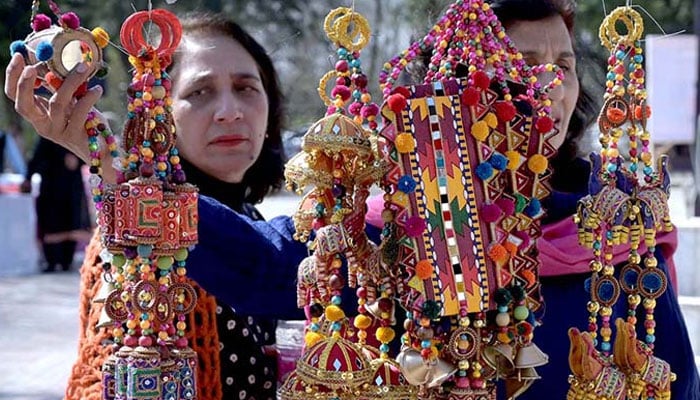Our Terms & Conditions | Our Privacy Policy
The decline of traditional crafts in Pakistan
Women visit stalls at 10th National Women at Work commemorating International Women’s Day organised by Lok Virsa with the collaboration of Devcom-Pakistan and dtn. — APP/File
Every Ajrak pattern, every swirl of truck art, and every stitch in a Peshawari chappal holds a part of Pakistan’s soul. These crafts are not just things people make; they’re stories – pieces of history and culture passed down for generations. But these stories are starting to fade. Traditional crafts in Pakistan are in trouble, struggling to stay relevant in a world where cheaper, machine-made alternatives have taken over.
Take Sindhi Ajrak, for example. This isn’t just fabric; it’s heritage. The deep reds and blues, the symmetrical patterns, they all reflect Sindhi culture. Yet the artisans who create Ajrak are barely making ends meet. Machine-made imitations are everywhere, sold for less and made in a fraction of the time. The same goes for Peshawari chappals. Once the pride of Khyber Pakhtunkhwa, these handmade shoes are being replaced by factory versions that are faster and cheaper to produce.
Truck art—a moving canvas that’s uniquely Pakistani—is also losing its charm. Where once truckers paid artists to decorate their vehicles with vibrant flowers, birds, and slogans, now many prefer plain, cost-effective designs. The artists who once made a living painting trucks are finding it harder and harder to get work.
So, what’s causing this decline? Part of it is the shift in priorities. People want things fast and cheap, and traditional crafts take time and effort. Globalization plays a role too. It’s brought in a flood of mass-produced goods that are easier to access and more affordable. Add to that the lack of support for artisans—no proper funding, no training programs, and very little marketing help. Even the younger generation isn’t interested in carrying on these traditions because they don’t see a future in it. Why learn a craft when you can’t make a living from it?
There have been some attempts to address this issue. You’ll see craft fairs and cultural festivals pop up every now and then, showcasing these dying arts. But these efforts feel like quick fixes. They bring temporary attention, sure, but they don’t solve the bigger problem. What happens after the festival ends? What’s the plan to keep these crafts alive long-term?
One way forward could be to blend tradition with modern demand. Imagine Ajrak patterns on trendy clothing or Peshawari chappals marketed to global audiences as luxury, handmade products. Big brands and businesses could partner with artisans to bring their work to the world stage. Another idea is to teach these crafts in schools and communities so that young people see their value—not just culturally but economically too.
Losing these crafts would be more than losing pretty designs or unique shoes. It would mean losing a part of our identity, a connection to the past. The stories of our culture, the pride of our regions, would all be gone. And once it’s gone, there’s no bringing it back. So, the question is, are we okay with letting that happen? Or are we ready to do something about it?
Images are for reference only.Images and contents gathered automatic from google or 3rd party sources.All rights on the images and contents are with their legal original owners.



Comments are closed.